A complete guide to making the best pulled pork recipe using Smoked Pork Shoulder (Pork Butt). Learn the tips and steps for tender pulled pork on your smoker. Plus a full video tutorial on How to Smoke Pork Shoulder.
You can also explore our no-wrap pork shoulder recipe or our Kalua Pork Recipe for more inspiration.
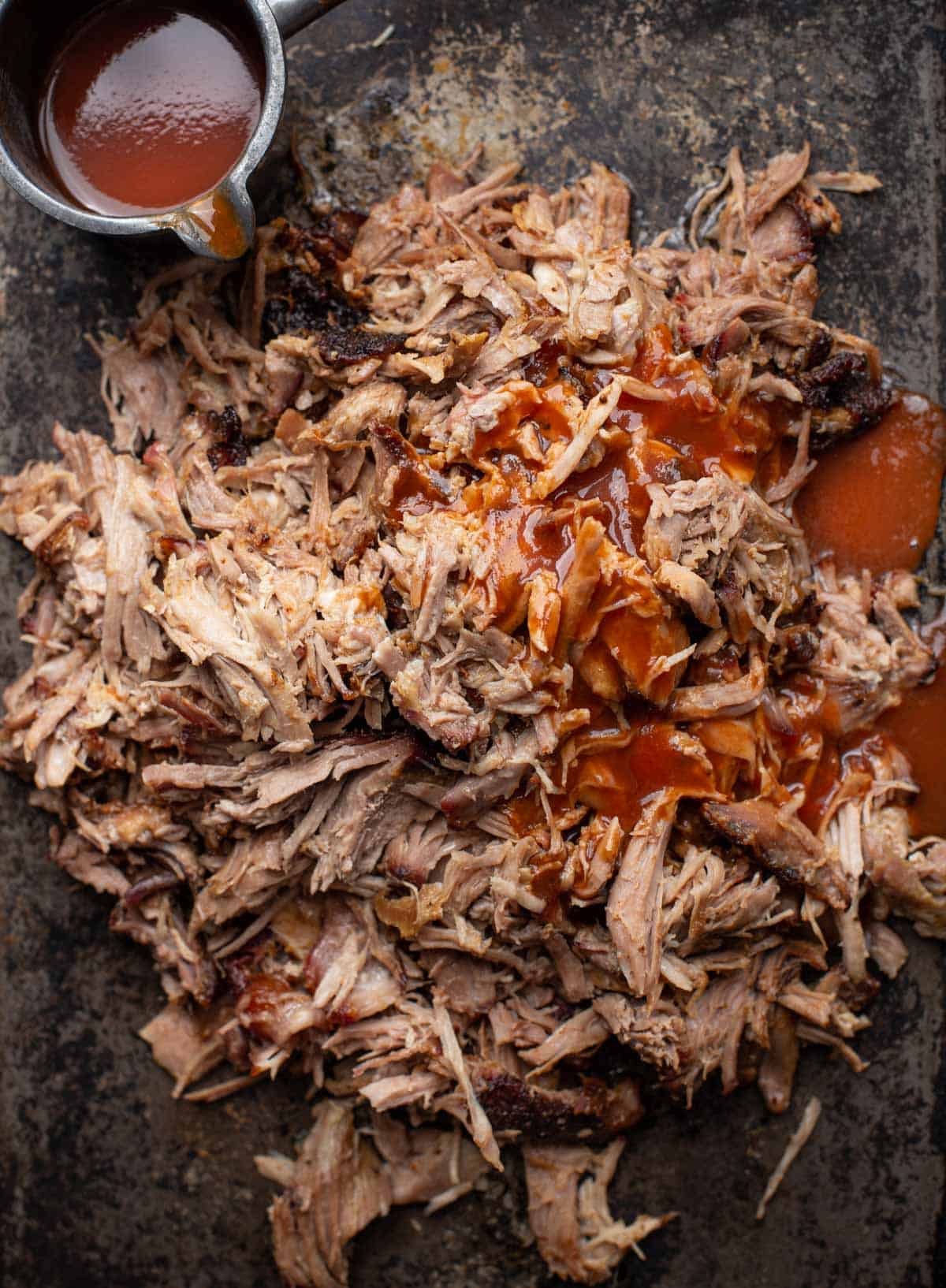
Recipe Highlights
- While there are different ways to smoke this cut of meat this method uses smoke then wrap until finished, which speeds up the cooking time.
- You can use this recipe on bone-in or boneless pork butts.
- The smoking process and fat from the connective tissue make this a great recipe to make ahead and then reheat for a crowd.
[feast_advanced_jump_to]
We’ve cooked A LOT of pork shoulders. Hundreds, in fact, both for our own personal consumption, as well as through our catering company, Ember and Vine. And we are here to share all we have learned through experimentation, awards, and questions from our community. Follow this guide for the perfect pulled pork flavor and texture.
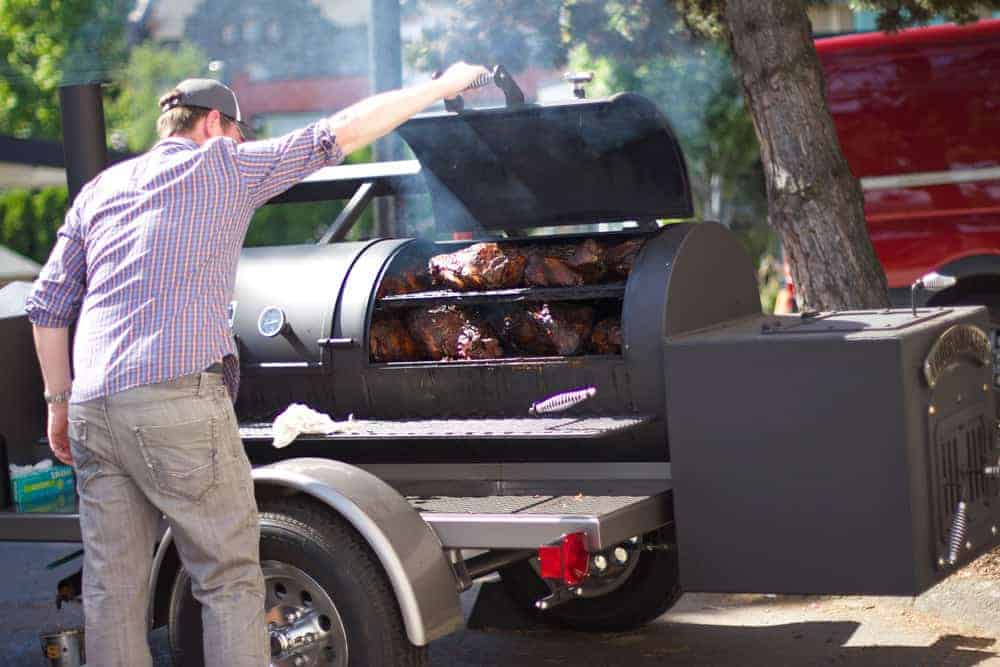
What is Pork Shoulder
Pork Shoulder is a dense muscle from the shoulder of the pig. The characteristics of the shoulder include pockets of intramuscular fat that are elongated and stringy in nature. Tucked inside the shoulder is another important muscle called the pork collar (or referred to “money muscle” when used in competition barbecue).
The shoulder may be called a number of things depending on how they are cut, and can come bone-less or bone-in. We prefer bone-in for smoking because it gives a more uniform shape. But you can use either for this recipe.
- Whole Pork Shoulder – This is typically a 12 – 14 pound pork shoulder that includes the actual shoulder just off the spine, as well as the upper portion of the leg, or picnic.
- Picnic – The lower portion of the shoulder and the bone in upper portion of the leg. This is easy to spot because it tapers down toward the leg with a triangular shape. These average 6 – 8 pounds.
- Boston Butt/Pork Butt – This is the shoulder that has been separated from the picnic. This cut is typically 6 – 8 pounds. The butt is still the shoulder and not to be confused with the ham, which is the rear of the pig.
- Partial Cuts – At times grocery stores will pre-slice pork shoulders into 3 – 4 pound cuts. We do not recommend using these for smoking.
- Boneless – Any of these cuts can be boneless. The butcher simply removes the bone and may tie the pork shoulder with butcher string.
Butchers Tip – When buying pork shoulder, if you see the word “Roast” be sure it is not Pork Loin. Pork Loin is a separate cooking process. Also if the cuts are small (3 – 4 pounds) ask the butcher if they have untrimmed whole shoulder or Boston Butt. Often they have them and you can trim them yourself.
The best way to cook pork shoulder is to smoke low and slow in order to slowly render the pockets of fat.
Selection
With beef, it is generally accepted that marbling is a key to flavor. So you have USDA cuts like choice or prime leading you to a “higher quality” beef. With pork, however, it’s not that easy. You have to go out of your way to get to the story behind the cut.
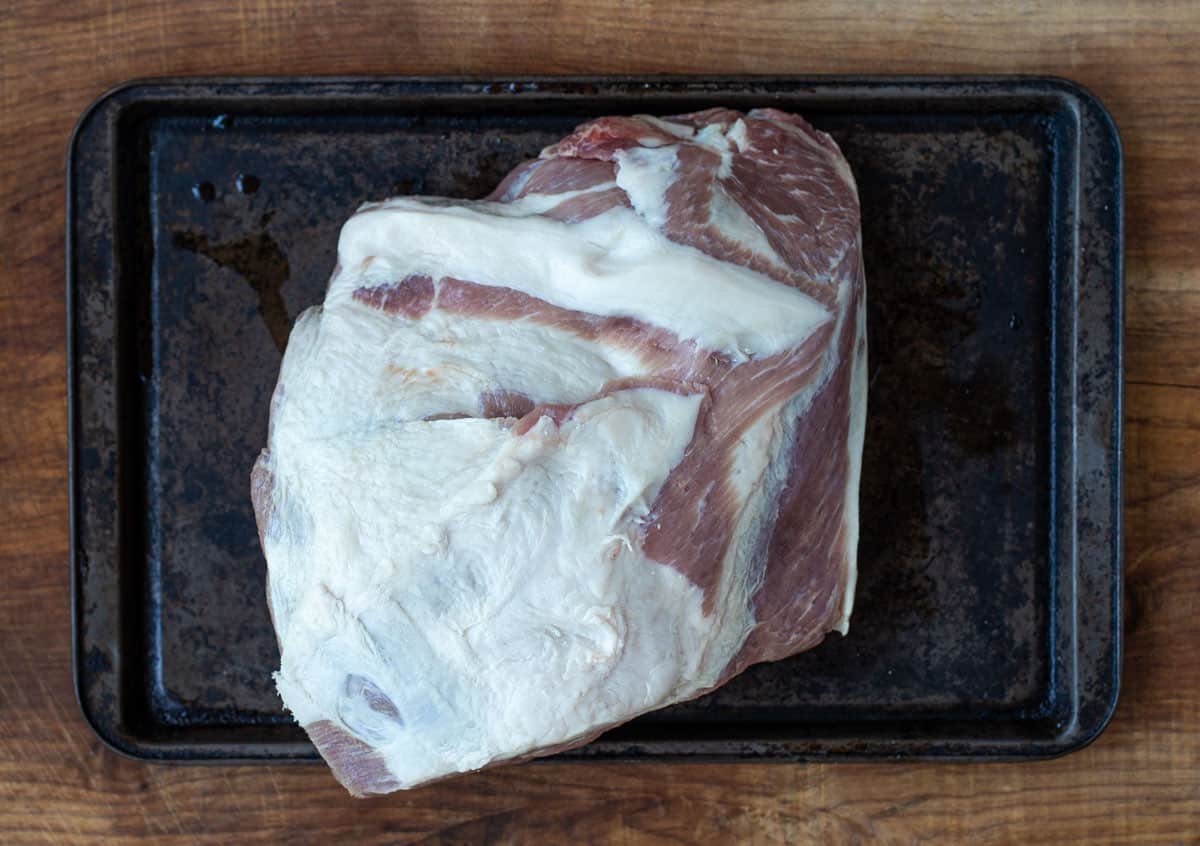
With pork shoulder or butt, the marbling is just as important to a long cook where you essentially are rendering all the fat as you cook, in order to get moisture into the meat.
- Look for fresh pink color with no odor. The fat cap and the meat should be firm. Our favorite purveyor of pork is Snake River Farms. Their Kurobuta Pork Shoulder is incredibly marbled and is the entire pork shoulder including the picnic.
- Buy bone-in shoulder. The bone helps keep the uniform squared shape for a shoulder and allows for more even cooking. The bone also acts as a temperature gauge for when the pork is done when it can easily slide out from the shoulder. However if all you can find is boneless that is fine as this recipe works the same.
Tools Needed
The following are some of our favorite tools to help us make killer pulled pork.
- Silicone Gloves by Ekogrips: These are fantastic when working with hot meat. The best part is that they are dishwasher safe, so you are assured you are working with clean and safe gloves. There are several silicone gloves out there, but these are the ones we use.
- Pork Puller: When we’re cooking several pork butts for a crowd we use this pork puller for speed and ease. You just attach it, just like a drill bit, to your drill and pull away. So easy and so awesome to make smoked pulled pork!
- Digital Thermometers: Temperature is key when cooking a large piece of meat like a pork butt. Every transition we make is determined by a specific temperature, so it’s vital to have a good thermometer. We recommend the Thermapen One for instant read and the Thermoworks Smoke Unit for monitoring the internal temperature of the roast throughout the cook.
- Aluminum Foil or Pink/Peach Butcher Paper for wrapping.
- For injecting our meat, we use a culinary injector and for a spritz we use a food safe spray bottle.
Trimming
There will be a fat cap on top of the pork butt that needs to be trimmed and some removal of any fatty pockets or potential glands using a sharp boning knife or filet knife.
Many will say to leave a hefty fat cap on the top of the shoulder. I have found that a super thick fat cap does not render out, resulting in a fairly large mass of fat when you’ve cooked it for 10+ hours and the loss of some potential surface area for bark (or that exterior flavor crust created by the smoke).
So my recommendation is to cut that fat cap to barely a ¼ inch on the topside. I actually prefer to shave it down to a razor thin layer. The fat inside the meat is what is more important.
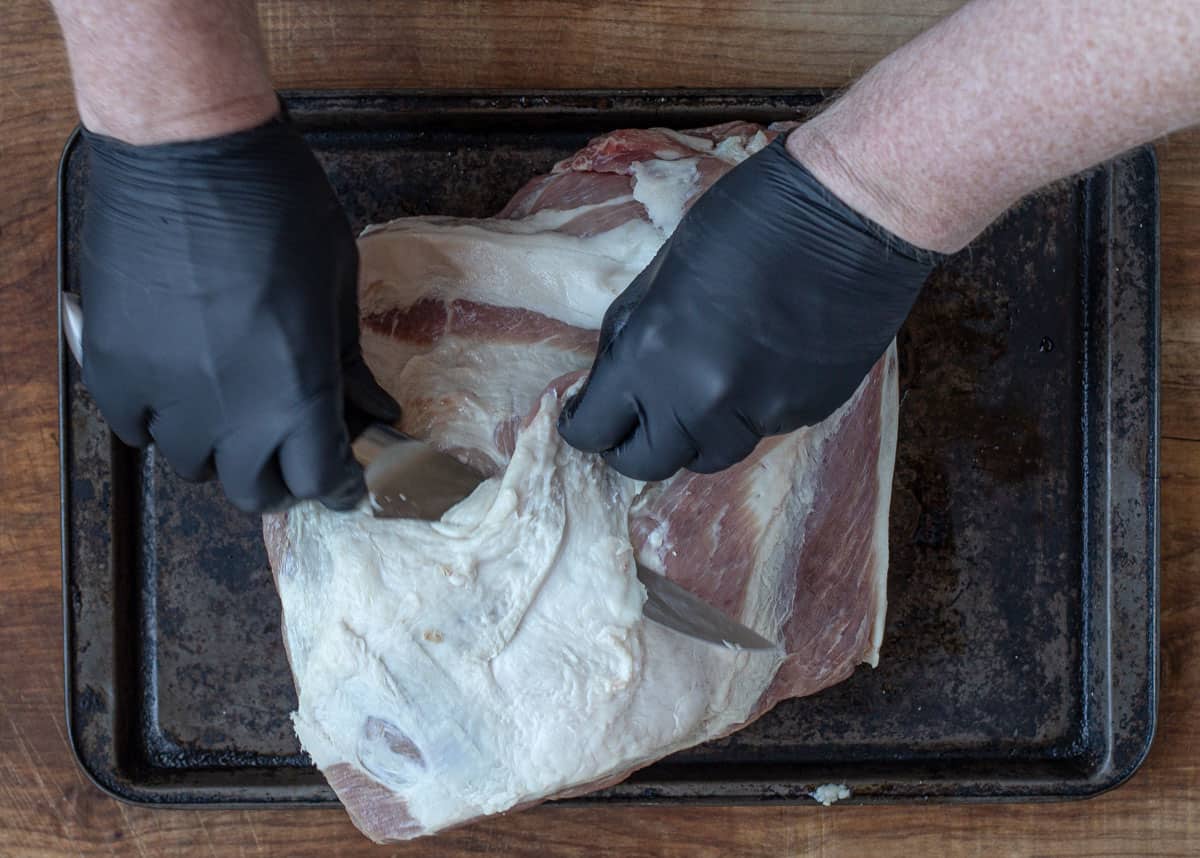
The remaining fat will still render, and you will get more flavor all around the meat. So don’t leave too much fat on the outside. Not to mention you still have fat inside the meat that is also rendering for flavor and moisture.
Trim the remaining sides. Sometimes you may see some glands on the non fat cap edges. They will be purple or red, those should come off too as the texture is not pleasant if you leave them on.
Preparation
We prefer to inject first (using a culinary syringe) then add the seasoning second. We use equal parts apple cider vinegar and apple juice or water to get moisture and flavor into the interior of the meat.
When injecting use a food injector and inject the liquid into 1-inch virtual cubes of space, you’ll see the pork expand or bulge. This is fine. Remember, you are going to be cooking this for several hours (10-14 hours depending on size), so that liquid will help keep the meat moist over that long duration of the cook as it warms and steams out.
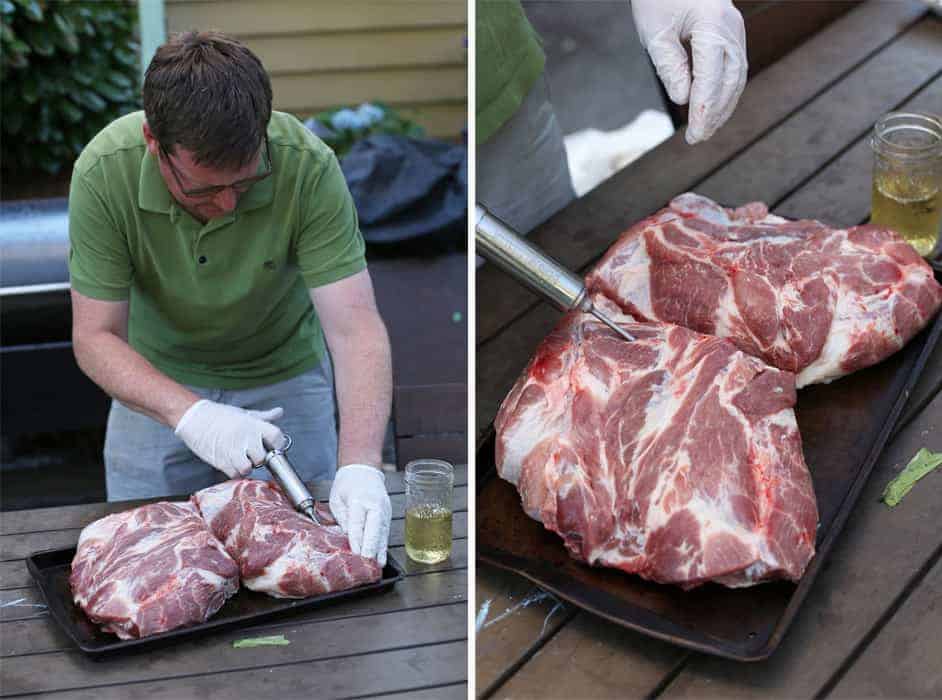
You like heat? Add some hot sauce to the injection. But in the end it’s adding moisture into the meat, that when warmed up will try to escape the meat and add that flavor all throughout the interior of the meat versus just the rub on the exterior.
Seasoning
Acidity matters for pork. So we start with a Dijon mustard slather (or binder) to allow the rub to stick. You can use extra virgin olive oil, beef stock, or any liquid you like. We prefer mustard.
Plan one cup of seasoning for the average 5 to 7 pound shoulder.
The pork butt rub will adhere to the slather. A good pork seasoning for pork shoulder will contain sugar and be slightly savory. Sugar helps with creating bark (or that dark caramelization that happens when smoking the shoulder). Want more savory? Lessen the sugar and add more salt, garlic, or onion powder. Just add all the ingredients into a bowl and mix.
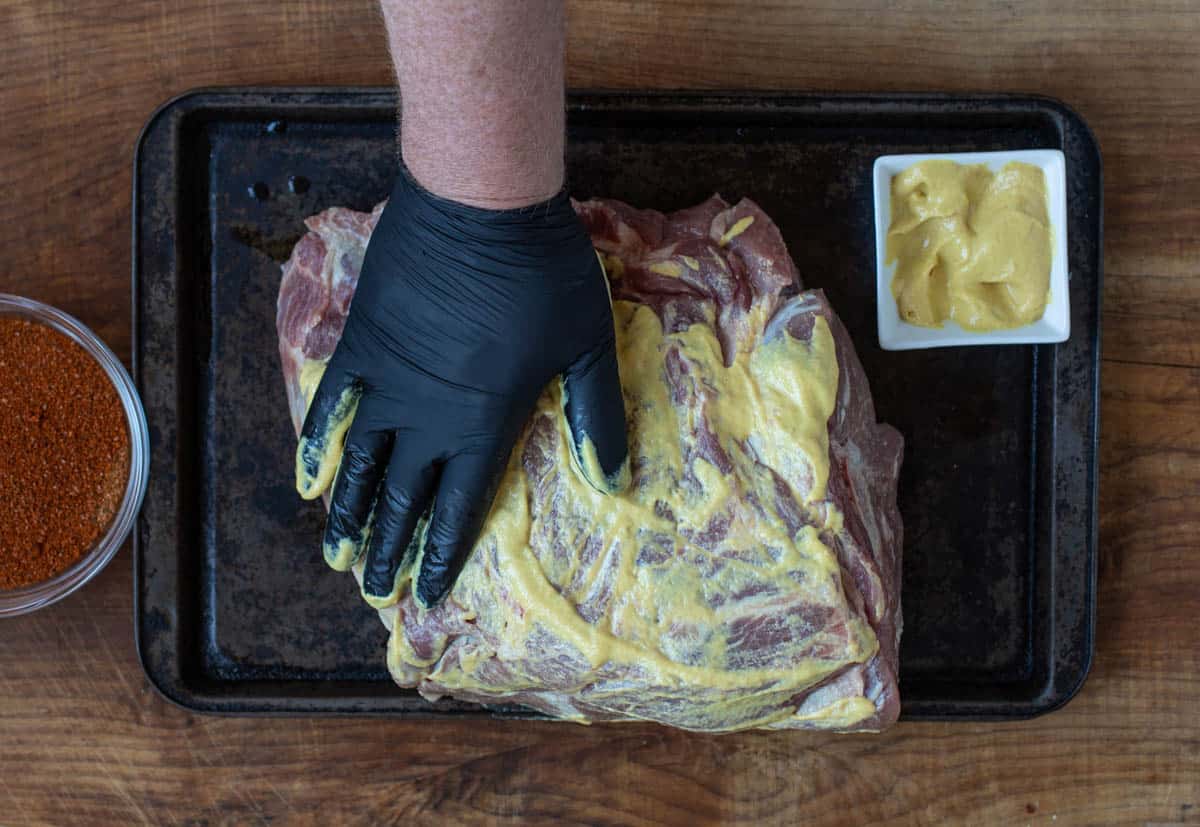
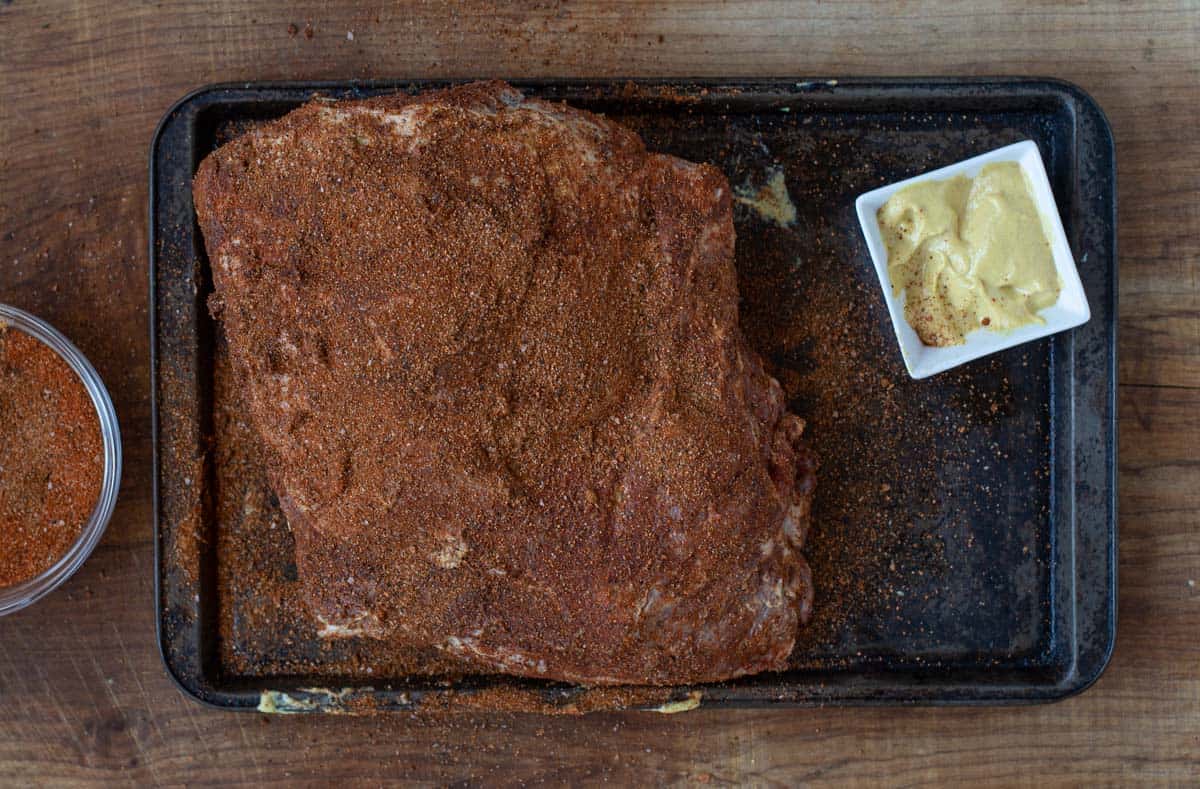
Pork Shoulder Dry Rub Ingredients:
- Brown Sugar (you can use dark or light)
- Kosher Salt
- Coarse Black Pepper
- Cumin
- Paprika
- Dry Mustard
- Cayenne
You can season the day of, or the day before. If you have time, do it the day before and then wrap the shoulder in foil or plastic wrap and keep in the refrigerator until ready to smoke.
Video Tutorial
How to Smoke a Pork Shoulder
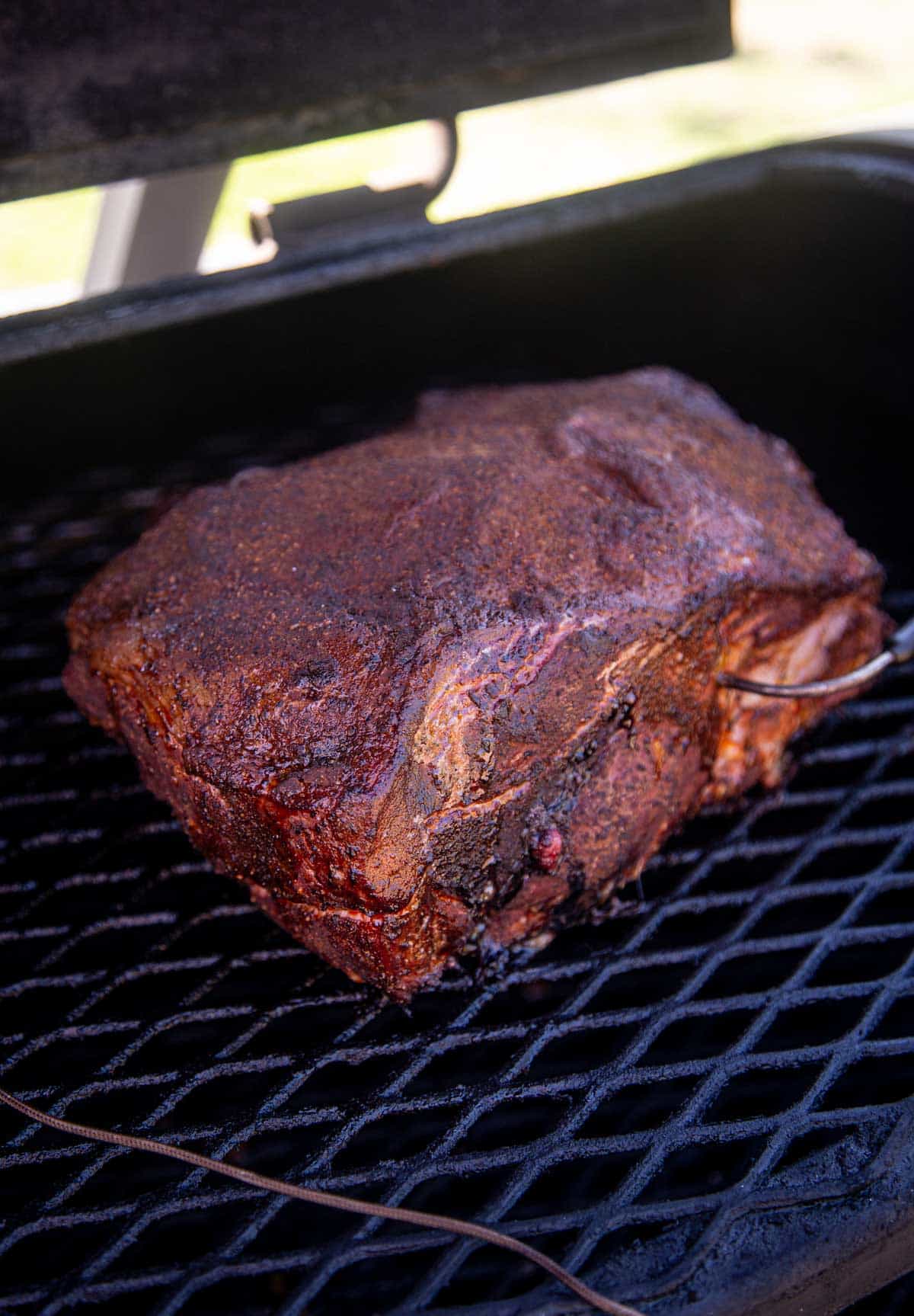
There are a few phases to smoking a pork shoulder after it has been trimmed and seasoned. Generally we plan 1 hour and 15 minutes per pound for total cook time, including the rest period. Better to be done early. A cooler (with no ice) can keep the shoulder warm for hours.
- Smoke – Target 250 degrees Fahrenheit for the first 3 – 4 hours.
- Spritz – After 3 – 4 hours of smoke, use a spray bottle to lightly spray the shoulder every 30 minutes until the internal temperature of the pork butt reaches 165 degrees F.
- Wrap – After the internal temperature of the pulled pork hits 165 degrees, wrap the shoulder in foil or butcher paper and reinsert your remote probe meat thermometer. See below for more details.
- Continue Smoking – Place back into smoker at 250 degrees and continue cooking until the pork shoulder reaches a range of 190 – 205 degrees F. In this range you will insert an instant read thermometer and check the temperature. When the probe goes into the shoulder it should feel like it’s entering into room temperature butter with no tension. If it is still a little tough, keep cooking. Another test for doneness is pulling on the bone, if it slides right out, it’s done. This process can take an additional 5 – 7 hours depending on the pork shoulder size. They key is cooking to temperature, not time.
- Rest – After the pork reaches the finished temperature, remove from smoker (still wrapped) and place in a cooler (with NO ice) for an hour, covered. This will allow the shoulder to slowly come down in temperature and redistribute all that amazing flavor and moisture. If your pork butt is done early you can hold in the cooler for up to four hours and keep it warm.
- Pull – Use your favorite tool and pull the pork into strings, that is when it becomes pulled pork. There will still be some cartilage and stringy fat. Be sure to discard those as you pull. See below for more details.
Pulled Pork Spritz
Make sure you have a food safe spray bottle. Fill it with equal parts apple cider vinegar and apple juice (or just apple cider vinegar and water, which is our preference to cut down on excess sweet. Or just get creative with your mixture).
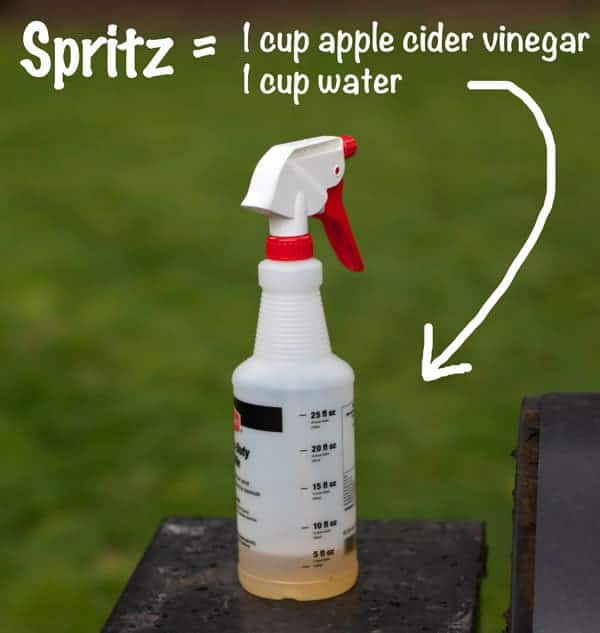
After three to four hours of smoke, you spray with this spritz every 30 minutes until you wrap. This cleanses off any ash that may have developed, but also coats the pork with a small liquid layer.
As smoke travels through the cooking chamber it is attracted to moisture. So this adds a lot of smoke flavor as the smoke connects with the spritz. We will spritz until the wrap. It takes only seconds to spritz, so you won’t be loosing much heat when you open up your cooker.
How To Wrap Pork Butt
Some choose not to wrap, which is fine, it just takes longer to smoke. I elect to wrap, and make sure I do so after the stall (see below for more details on the stall), which is when the shoulder internal temperature reaches 165 degrees F.
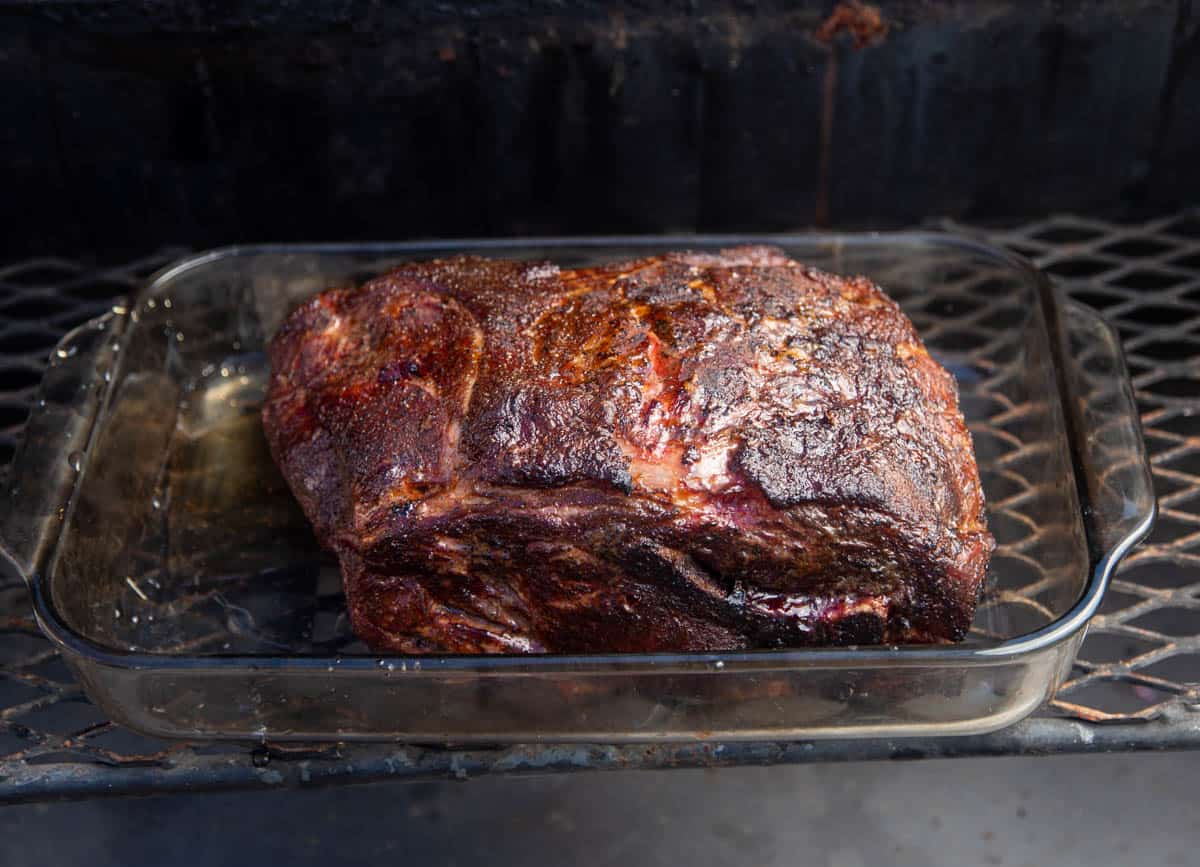
Place shoulder in a large aluminum baking pan, cookie sheet, or even a glass dish. Add a couple tablespoons of the spritz liquid into the pan and then wrap to top in foil. Insert the remote thermometer probe again through the wrap and then return to the smoker. Be sure the probe is not touching the bone. Using a pan retains a lot of the juices and fat which is flavor when you pull.
Alternatively you can use aluminum foil or pink butcher paper and wrap it tightly.
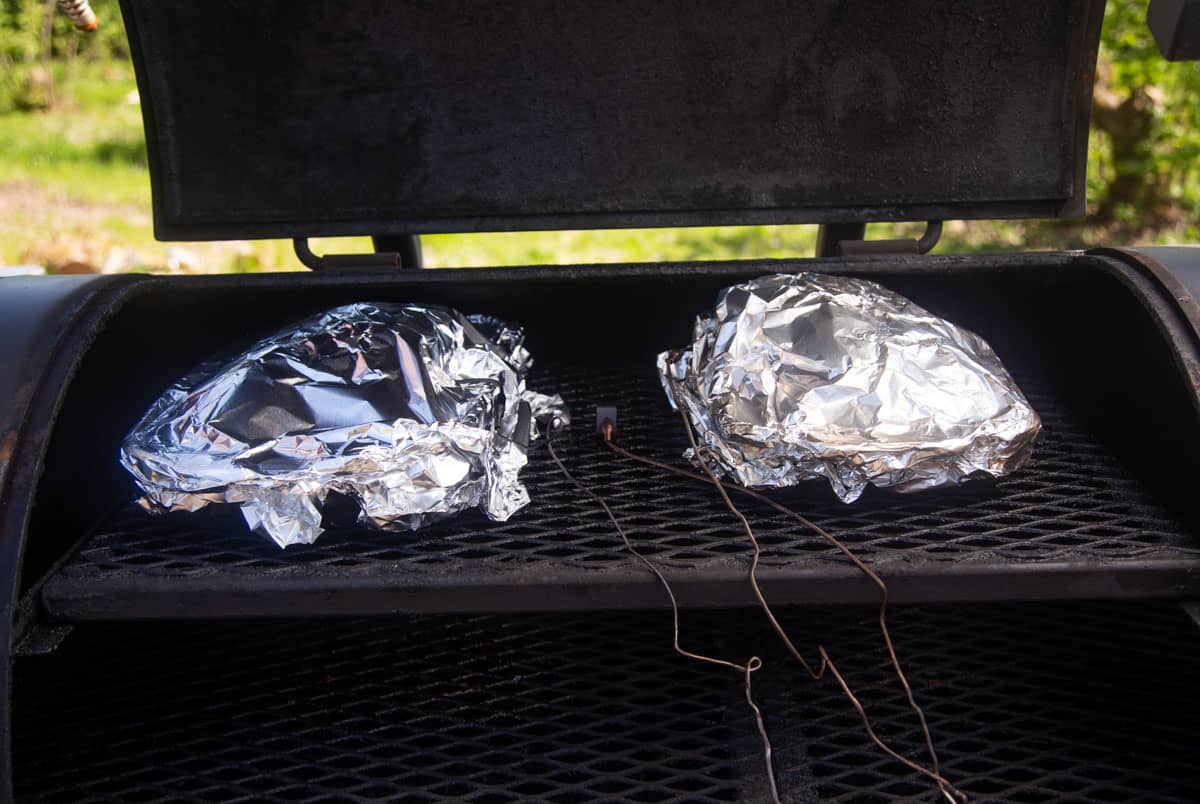
How Long to Cook Pork Butt
As stated earlier plan 1 hour and 15 minutes per pound, on average, when cooking at 250 degrees Fahrenheit.
- 5 pounds – 6-7 hours
- 7 pounds – 8-9 hours
- 8 pounds – 9-11 hours
How to Pull a Smoked Pork Shoulder
- If you have given your meat enough time to properly cool to temperature, you can pull with your hands to make the smoked pulled pork. When we’re cooking at an event and have several to pull, we use a tool that attaches to a drill (it’s awesome). It makes it SOOO easy to finish the job.
- But when we’re cooking just one or two at home, we love these gloves. They make it very easy to pull, and the gloves are dishwasher safe.
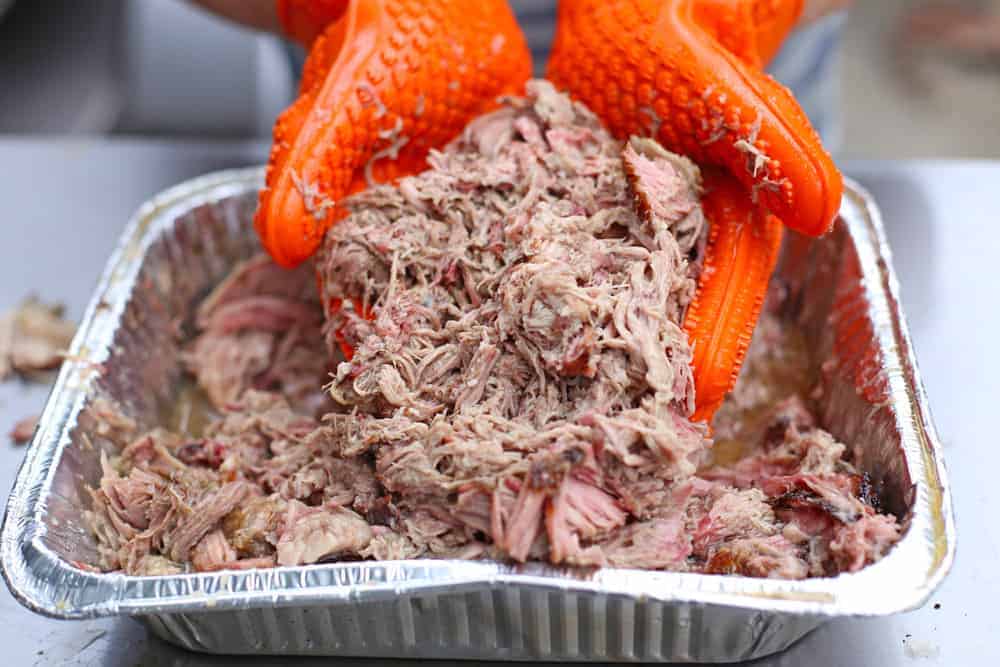
- Remove the pork from the cooler and foil wrap. Take out the bone and start slowly shredding the meat with your fingers. As you pull you may find some minor pieces of fat or cartilage that you want to discard. Get it pulled to your desired consistency and then cover again until ready to serve.
- Want a little extra flavor? Add some apple cider vinegar after it’s pulled. Or add your favorite BBQ sauce if you want. The key is to enjoy that pork shoulder and flavor and not over-smoke it.
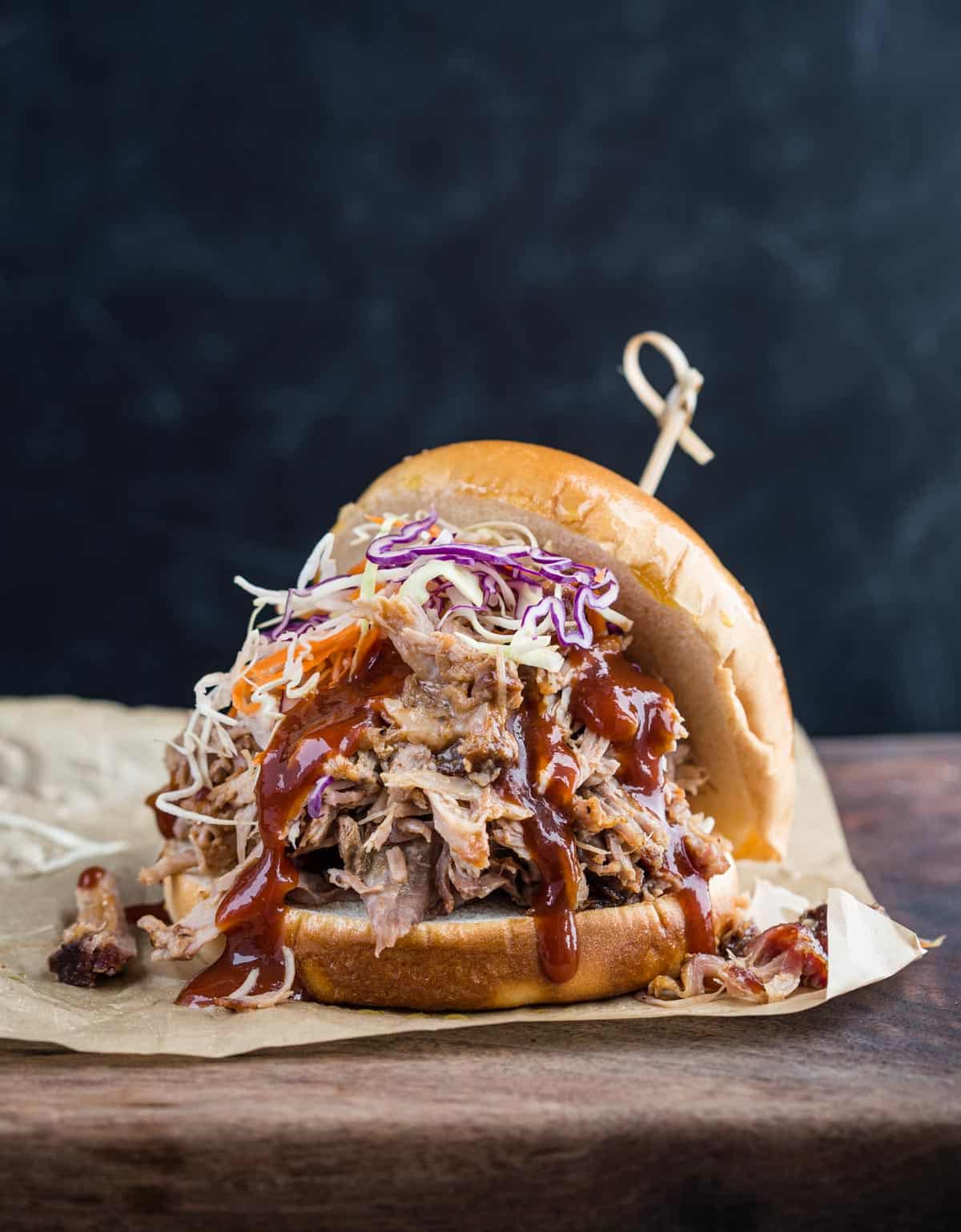
***Pork butts come in a variety of sizes and weights. They can get BIG! The “Boston Butt” is typically what we use, the nice rectangular shoulder meat. The “picnic” looks like a ham, it’s the upper part of the leg, with less meat. Usually if cooked, it’s cooked separately.
Frequently Asked Questions (FAQ)
Preheat oven to 300 degrees. Place pulled pork in an oven safe dish. Add ¼ cup of apple cider vinegar or your favorite barbecue sauce and then cover with foil. Place into the oven for 20 minutes. The liquid from vinegar will steam to re-hydrate the smoked pulled pork and the fat will re-liquefy.
The stall is when the meat sweats liquid while cooking. As the meat sweats from the cells, it cools the meat down again. The stall is represented when you see very little movement in the internal temperature of the pork shoulder. It may be hours and only moves 5 – 6 degrees.
You have to make sure to not overreact to the stall when cooking, instead embrace it and cook through it. As the moisture cooks out, which is all that intramuscular fat rendering out, the internal temperature of the pork shoulder will start to rise again at a faster pace. When the pork shoulder internal temperature reaches around 165 – 170 degrees F it is likely out of the stall.
Any fruit wood like apple, cherry, or peach is a great wood for pulled pork. Fruit woods burn sweeter with less of a campfire flavor.
On average it’s an additional 4 to 5 hours from the beginning of the stall until the pork shoulder finishes at 203.
On average a six pound pork shoulder takes roughly 8 hours to cook. Plan 1 hour and 15 minutes per pound as a general range for a pork shoulder.
Additional Recipe Inspirations
- Vinegar Based BBQ Sauce
- Dry Rub Resources
- No Mayo Coleslaw
- Pulled Pork Sliders with Grilled Pineapple
Uses for Leftover Smoked Pulled Pork
When you’re experimenting with pulled pork, like we tend to do, you may find yourself with some leftovers. Here are a few favorite uses for leftover pulled pork:
- Pork Shoulder Tacos
- Pulled Pork Nachos
- Pulled Pork Spring Rolls
- Leftover Pulled Pork Wontons
- Smoked Pulled Pork Hash The ultimate brunch!
- And so much more! Try it on pizza, pulled pork sloppy joes, pulled pork mac and cheese. The options are endless!
*This post contains affiliate links for some of our favorite products. We’ve used and abused everything mentioned, and they’re still going strong! We only recommend products we think are totally worthy of your love and investment!
This post was originally created in 2016 and has been updated August 2022 with more Q and A and reader questions answered.
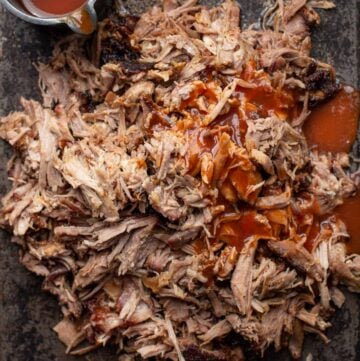
Smoked Pulled Pork Butt Recipe
#wprm-recipe-user-rating-0 .wprm-rating-star.wprm-rating-star-full svg * { fill: #ffffff; }#wprm-recipe-user-rating-0 .wprm-rating-star.wprm-rating-star-33 svg * { fill: url(#wprm-recipe-user-rating-0-33); }#wprm-recipe-user-rating-0 .wprm-rating-star.wprm-rating-star-50 svg * { fill: url(#wprm-recipe-user-rating-0-50); }#wprm-recipe-user-rating-0 .wprm-rating-star.wprm-rating-star-66 svg * { fill: url(#wprm-recipe-user-rating-0-66); }linearGradient#wprm-recipe-user-rating-0-33 stop { stop-color: #ffffff; }linearGradient#wprm-recipe-user-rating-0-50 stop { stop-color: #ffffff; }linearGradient#wprm-recipe-user-rating-0-66 stop { stop-color: #ffffff; }
Ingredients
- 1 8-10 lb pork shoulder, or boston butt
- 2 tablespoons Dijon mustard
Dry Rub:
- ¼ cup brown sugar
- ¼ cup salt
- 1 tablespoon chili powder
- 1 tablespoon smoked paprika
- ½ tablespoon dry mustard
- ½ tablespoon cumin
- ½ teaspoon cayenne
- 2 teaspoons garlic powder
- 1 teaspoon onion powder
Injection:
- 1 cup of apple cider vinegar
- 1 cup apple juice
Spritz:
- 1 cup apple cider vinegar
- 1 cup water
Instructions
For the Pork Dry Rub
-
Combine all ingredients in a bowl and mix. Use about ¼ cup of the rub and store the remainder in a mason jar for up to six months.
For the Spritz
-
Combine the apple cider vinegar and water in a food safe spray bottle.
How to Smoke Pork Shoulder
-
The night before cooking, prepare pork. Remove excess fat cap, and any glands. Pat dry with paper towel and then place onto a baking sheet, and inject the meat. Discard any liquid that pools in the pan and then pat dry the pork again.
-
Apply mustard and then dry rub thoroughly. If you don’t have time to do the night before try to apply at least an hour before cooking. You’ll see the rub begin to liquefy as the moisture connects with the meat.
-
Preheat smoker to 250 degrees Fahrenheit. We use apple or cherry wood. Insert a thermometer if you have a remote probe, and leave in place.
-
Place the pork fat cap side up (if you left the cap on) and smoke for about three hours. You’ll see a bark begin to develop, if it hasn’t continue smoking one more hour. After you see a mahogany color and bark, spritz (or spray) every 30 minutes. After about five hours total, check the temperature. When the pork hits on or around 165 degrees Fahrenheit, it’s likely coming out of the stall and ready to wrap. This will change from meat to meat, you will see the temperature hover and only go up in a few degrees per hour. It pushes through the stall when you start to see the temperature increase in a much faster pace (between 165 to 175).
-
As you complete the stall, (remove the thermometer at this point if you have one) place the pork shoulder into a pan, add a small amount (two tablespoons) of your spritz into the pan and wrap in foil tightly. Put the thermometer back in place.
-
Continue cooking wrapped until the internal temperature is between 200 and 203. Use an instant read thermometer. It should slide right in as if it is room temperature butter.
-
Remove from smoker (leave wrapped). Place into a cooler (with NO ice) and let it rest for an hour. It will act as a warmer and keep the pork warm for hours, so if you are planning an event, better to be done early and let it sit.
-
After one hour, remove from cooler and begin pulling. Remove the bone (it will just slide right out clean), and then pull with your favorite tool or with your hands. It is likely there will be some cartilage or other fatty pieces, be sure to pull those out (it’s not a good texture).
-
You may also opt to add a few tablespoons of BBQ sauce to mix in as well, or just top your pulled pork sandwiches with it. See BBQ sauce in notes, and also a link below the video.
Video
Notes
*Time – This time is for a 7 – 8 pound shoulder. Every shoulder will cook differently, so adjust your cooking time up if a larger shoulder. Typically we plan 1 hour and 15 minutes for every pound including the rest time for total cook time.
*Please see extended instructions above for full description.
*For our favorite dry rub for pulled pork, see this post and video for variations.
*For the Vinegar Based BBQ Sauce.
Find the perfect wine pairing at the Vindulge Wine Shop
Nutrition
The post Perfect Smoked Pork Butt Recipe (Pulled Pork Shoulder) appeared first on Vindulge.